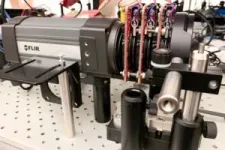(Press-News.org) WASHINGTON — Researchers have developed a new technology that uses meta-optical devices to perform thermal imaging. The approach provides richer information about imaged objects, which could broaden the use of thermal imaging in fields such as autonomous navigation, security, thermography, medical imaging and remote sensing.
“Our method overcomes the challenges of traditional spectral thermal imagers, which are often bulky and delicate due to their reliance on large filter wheels or interferometers,” said research team leader Zubin Jacob from Purdue University. “We combined meta-optical devices and cutting-edge computational imaging algorithms to create a system that is both compact and robust while also having a large field of view.”
In Optica, Optica Publishing Group’s journal for high-impact research, the authors describe their new spectro-polarimetric decomposition system, which uses a stack of spinning metasurfaces to break down thermal light into its spectral and polarimetric components. This allows the imaging system to capture the spectral and polarization details of thermal radiation in addition to the intensity information that is acquired with traditional thermal imaging.
The researchers showed that the new system can be used with a commercial thermal camera to successfully classify various materials, a task that is typically challenging for conventional thermal cameras. The method’s ability to distinguish temperature variations and identify materials based on spectro-polarimetric signatures could help boost safety and efficiency for a variety of applications, including autonomous navigation.
“Traditional autonomous navigation approaches rely heavily on RGB cameras, which struggle in challenging conditions like low light or bad weather,” said the paper’s first author Xueji Wang, a postdoctoral researcher at Purdue University. “When integrated with heat-assisted detection and ranging technology, our spectro-polarimetric thermal camera can provide vital information in these difficult scenarios, offering clearer images than RGB or conventional thermal cameras. Once we achieve real-time video capture, the technology could significantly enhance scene perception and overall safety.”
Doing more with a smaller imager
Spectro-polarimetric imaging in the long-wave infrared is crucial for applications such as night vision, machine vision, trace gas sensing and thermography. However, today’s spectro-polarimetric long-wave infrared imagers are bulky and limited in spectral resolution and field of view.
To overcome these limitations the researchers turned to large-area metasurfaces — ultra-thin structured surfaces that can manipulate light in complex ways. After engineering spinning dispersive metasurfaces with tailored infrared responses, they developed a fabrication process that allowed these metasurfaces to be used to create large-area (2.5-cm diameter) spinning devices suitable for imaging applications. The resulting spinning stack measures less than 10 x 10 x 10 cm and can be used with a traditional infrared camera.
“Integrating these large-area meta-optical devices with computational imaging algorithms facilitated the efficient reconstruction of the thermal radiation spectrum,” said Wang. “This enabled a more compact, robust and effective spectro-polarimetric thermal imaging system than was previously achievable.”
Classifying materials with thermal imaging
To evaluate their new system, the researchers spelled out “Purdue” using various materials and microstructures, each with unique spectro-polarimetric properties. Using the spectro-polarimetric information acquired with the system, they accurately distinguished the different materials and objects. They also demonstrated a three-fold increase in material classification accuracy compared to traditional thermal imaging methods, highlighting the system's effectiveness and versatility.
The researchers say that the new method could be especially useful for applications that require detailed thermal imaging. “In security, for example, it could revolutionize airport systems by detecting concealed items or substances on people,” said Wang. “Moreover, its compact and robust design enhances its suitability for diverse environmental conditions, making it particularly beneficial for applications such as autonomous navigation.”
In addition to working to achieve video capture with the system, the researchers are trying to enhance the technique’s spectral resolution, transmission efficiency and speed of image capture and processing. They also plan to improve the metasurface design to enable more complex light manipulation for higher spectral resolution. Additionally, they want to extend the method to room-temperature imaging since the use of metasurface stacks restricted the method to high-temperature objects. They plan to do this using improved materials, metasurface designs and techniques like anti-reflection coatings.
Paper: X. Wang, Z. Yang, F. Bao, T. Sentz, Z. Jacob, “Spinning Metasurface Stack for Spectro-polarimetric Thermal Imaging,” 11, 1 (2024).
DOI:10.1364/OPTICA.506813.
About Optica
Optica is an open-access journal dedicated to the rapid dissemination of high-impact peer-reviewed research across the entire spectrum of optics and photonics. Published monthly by Optica Publishing Group, the Journal provides a forum for pioneering research to be swiftly accessed by the international community, whether that research is theoretical or experimental, fundamental or applied. Optica maintains a distinguished editorial board of more than 60 associate editors from around the world and is overseen by Editor-in-Chief Prem Kumar, Northwestern University, USA. For more information, visit Optica.
About Optica Publishing Group (formerly OSA)
Optica Publishing Group is a division of Optica (formerly OSA), Advancing Optics and Photonics Worldwide. It publishes the largest collection of peer-reviewed content in optics and photonics, including 18 prestigious journals, the society’s flagship member magazine, and papers from more than 835 conferences, including 6,500+ associated videos. With over 400,000 journal articles, conference papers and videos to search, discover and access, Optica Publishing Group represents the full range of research in the field from around the globe.
END
Researchers use spinning metasurfaces to craft compact thermal imaging system
By capturing more detailed thermal information, new approach could be useful for autonomous navigation, material identification, security and more
2024-01-11
ELSE PRESS RELEASES FROM THIS DATE:
John E. Carlstrom wins 2024 Dannie Heineman Prize for Astrophysics
2024-01-11
WASHINGTON, Jan. 11, 2024 – The Heineman Foundation, American Institute of Physics, and American Astronomical Society are pleased to announce John E. Carlstrom as the winner of the 2024 Dannie Heineman Prize for Astrophysics.
Carlstrom was selected “for pioneering work on microwave interferometry and his leading role in the development of the South Pole Telescope, leading to the observations of clusters of galaxies through the Sunyaev-Zeldovich effect, B-Mode polarization in the cosmic microwave background and strong evidence for a flat universe, all of which changed the field for generations to come.”
“AIP congratulates ...
Intriguing insights uncovered for two rare heart muscle diseases
2024-01-11
PHILADELPHIA— Advancements in the study of two rare heart conditions—peripartum cardiomyopathy (PPCM), and dilated cardiomyopathy (DCM)—contributed by researchers at the Perelman School of Medicine at the University of Pennsylvania may serve as critical guides in future work toward developing therapies for the conditions. The lab of Zoltan Arany, MD, PhD, the Samuel Bellet Professor of Cardiology and a professor of Cell and Developmental Biology, published their findings this month in the New England Journal of Medicine (NEJM), adding to separate research they recently published in the Journal of Clinical ...
Study finds AI-driven eye exams increase screening rates for youth with diabetes
2024-01-11
FOR IMMEDIATE RELEASE
A Johns Hopkins Children’s Center study of children and youth with diabetes concludes that so-called autonomous artificial intelligence (AI) diabetic eye exams significantly increase completion rates of screenings designed to prevent potentially blinding diabetes eye diseases (DED). During the exam, pictures are taken of the backs of the eyes without the need to dilate them, and AI is used to provide an immediate result.
The study noted that the AI-driven technology used in the exams may close “care gaps” among racial and ethnic minority youth with diabetes, populations with historically higher rates of DED and less access to or adherence ...
U.S. health costs related to chemicals in plastics reached $250 billion in 2018
2024-01-11
WASHINGTON—Endocrine-disrupting chemicals (EDCs) in plastics pose a serious threat to public health and cost the U.S. an estimated $250 billion in increased health care costs in 2018, according to new research published in the Journal of the Endocrine Society.
Plastics contain many hazardous, endocrine-disrupting chemicals that leach and contaminate humans and the environment. These chemicals disturb the body’s hormone systems and can cause cancer, diabetes, reproductive disorders, neurological impairments of developing fetuses and children, and death.
Potential options under discussion as part of a Global ...
Experiments in infant mice suggest new way to prevent spread of flu in people
2024-01-11
Scientists have long known that some viruses and bacteria begin infections by latching first onto sugar molecules on the surfaces of cells lining the sinuses and throat of mammals, including humans. Viral particles, for instance, can attach to these molecules, called sialic acids, or SAs, like keys fitting into locks.
Now, a new study in infant mice shows that keeping virus particles from attaching to SAs limits more than just the entry of influenza A viral infections, but also hinders their exit (shedding) and transmission from mouse to mouse. Such infections are the main cause of the seasonal flu that kills more than 36,000 Americans annually. While vaccines to guard ...
A universal coronavirus vaccine could save billions of dollars if ready before next pandemic
2024-01-11
What if scientists had developed a universal coronavirus vaccine in the years prior to 2020 so that it was available at the start of the COVID-19 pandemic? A universal coronavirus vaccine targets parts of the virus that are common to either many or all coronaviruses, thereby offering some degree of protection against a range of strains. A new study suggests if such a vaccine were available at the start of the pandemic, it could have saved millions of lives, prevented suffering, and saved billions of dollars in direct medical ...
Virtual Science Writers Conference will uncover the truth behind ‘hormone balancing’
2024-01-11
WASHINGTON—The popular TikTok trend of ‘hormone balancing’ has taken over the internet with claims to balance your hormones with holistic approaches alone, but medical experts question its legitimacy.
Endocrine Society expert Deena Adimoolam, M.D., will discuss ‘hormone balancing’ during the Society’s Virtual Science Writers Conference on January 24.
What: The Virtual Science Writers Conference will examine:
How hormones function and stay in balance
Common ...
Toxic algae blooms: Study assesses potential health hazards to humans
2024-01-11
Florida’s 156-mile-long Indian River Lagoon (IRL) borders five different counties and has five inlets that connect the lagoon with the Atlantic Ocean. In recent years, this estuary has experienced numerous phytoplankton bloom events due to increased seasonal temperatures coupled with environmental impacts.
Algal blooms produce a myriad of small organic molecules, many of which can be toxic to humans and animals. Among these phycotoxin producers is Microcystis aeruginosa, a freshwater cyanobacterium, which can be found in the Southern IRL. Measurable amounts of microcystins have been found in nasal swabs ...
Researchers discover potential microbiome links to skin aging
2024-01-11
The effects of aging and external factors like UV exposure on skin are well documented. As people age or spend more time in the sun, their skin tends to become drier and more wrinkled,
Recent findings have identified an exciting potential new link to signs of skin aging—the skin microbiome, the collection of microorganisms that inhabits our skin. The results come from a collaborative study carried out by researchers at the Center for Microbiome Innovation (CMI) at the University of California San Diego (UC San Diego) and L'Oréal ...
Join us in sunny San Diego for the ATS 2024 International Conference May 19-22
2024-01-11
What’s New: Register now to learn about the latest in pulmonary, critical care and sleep medicine. Join us for scientific sessions and expert interviews. Thirteen sessions will be livestreamed.
Why it matters: Stay up-to-date on subjects like COVID-19, asthma, COPD, and air pollution. We’ll assist you with conducting interviews, whether in-person or from your home office.
Contact Kevin Tuerff, ATS Communications & Marketing for more information, at ktuerff@thoracic.org END ...
LAST 30 PRESS RELEASES:
Scientists trace microplastics in fertilizer from fields to the beach
The Lancet Obstetrics, Gynecology, & Women’s Health: Taking paracetamol during pregnancy does not increase risk of autism, ADHD or intellectual disabilities, confirms new gold-standard evidence review
Taking paracetamol during pregnancy does not increase risk of autism, ADHD or intellectual disabilities
Harm reduction vending machines in New York State expand access to overdose treatment and drug test strips, UB studies confirm
University of Phoenix releases white paper on Credit for Prior Learning as a catalyst for internal mobility and retention
Canada losing track of salmon health as climate and industrial threats mount
Molecular sieve-confined Pt-FeOx catalysts achieve highly efficient reversible hydrogen cycle of methylcyclohexane-toluene
Investment in farm productivity tools key to reducing greenhouse gas
New review highlights electrochemical pathways to recover uranium from wastewater and seawater
Hidden pollutants in shale gas development raise environmental concerns, new review finds
Discarded cigarette butts transformed into high performance energy storage materials
Researchers highlight role of alternative RNA splicing in schizophrenia
NTU Singapore scientists find new way to disarm antibiotic-resistant bacteria and restore healing in chronic wounds
Research suggests nationwide racial bias in media reporting on gun violence
Revealing the cell’s nanocourier at work
Health impacts of nursing home staffing
Public views about opioid overdose and people with opioid use disorder
Age-related changes in sperm DNA may play a role in autism risk
Ambitious model fails to explain near-death experiences, experts say
Multifaceted effects of inward foreign direct investment on new venture creation
Exploring mutations that spontaneously switch on a key brain cell receptor
Two-step genome editing enables the creation of full-length humanized mouse models
Pusan National University researchers develop light-activated tissue adhesive patch for rapid, watertight neurosurgical sealing
Study finds so-called super agers tend to have at least two key genetic advantages
Brain stimulation device cleared for ADHD in the US is overall safe but ineffective
Scientists discover natural ‘brake’ that could stop harmful inflammation
Tougher solid electrolyte advances long-sought lithium metal batteries
Experts provide policy roadmap to reduce dementia risk
New 3D imaging system could address limitations of MRI, CT and ultrasound
First-in-human drug trial lowers high blood fats
[Press-News.org] Researchers use spinning metasurfaces to craft compact thermal imaging systemBy capturing more detailed thermal information, new approach could be useful for autonomous navigation, material identification, security and more




